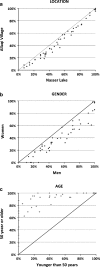Vanishing Knowledge of Plant Species in the Wadi Allaqi Desert Area of Egypt
- PMID: 27642218
- PMCID: PMC5011154
- DOI: 10.1007/s10745-016-9826-9
Vanishing Knowledge of Plant Species in the Wadi Allaqi Desert Area of Egypt
Figures




Similar articles
-
Natural radioactivity levels and radiation hazard indices in granite from Aswan to Wadi El-Allaqi southeastern desert, Egypt.Radiat Prot Dosimetry. 2007;124(2):148-54. doi: 10.1093/rpd/ncm211. Epub 2007 Jun 14. Radiat Prot Dosimetry. 2007. PMID: 17569689
-
Radiometric characteristics of some metallic ores and nonmetallic deposits: an example, Wadi Al-Allaqi, South Eastern Desert, Egypt.Sci Rep. 2024 Jan 30;14(1):2443. doi: 10.1038/s41598-024-52912-9. Sci Rep. 2024. PMID: 38287098 Free PMC article.
-
Mycoflora associated with Hyoscyamus muticus growing under an extremely arid desert environment (Aswan region, Egypt).J Basic Microbiol. 2008 Apr;48(2):82-92. doi: 10.1002/jobm.200700107. J Basic Microbiol. 2008. PMID: 18383230
-
Some biomedical applications of Balanites aegyptiaca grown naturally in radioactive area, Southeastern Desert, Egypt.J Hazard Mater. 2010 Jun 15;178(1-3):725-8. doi: 10.1016/j.jhazmat.2010.02.002. Epub 2010 Feb 4. J Hazard Mater. 2010. PMID: 20226589
-
Natural radionuclide concentrations in granite rocks in Aswan and Central-Southern Eastern Desert, Egypt and their radiological implications.Radiat Prot Dosimetry. 2012 Jul;150(4):488-95. doi: 10.1093/rpd/ncr437. Epub 2011 Dec 5. Radiat Prot Dosimetry. 2012. PMID: 22147926
Cited by
-
Classification of a new phytoplasmas subgroup 16SrII-W associated with Crotalaria witches' broom diseases in Oman based on multigene sequence analysis.BMC Microbiol. 2017 Nov 25;17(1):221. doi: 10.1186/s12866-017-1130-3. BMC Microbiol. 2017. PMID: 29178845 Free PMC article.
References
-
- Ali MM, Dickinson G, Murphy KJ. Predictors of Plant Diversity in a Hyperarid Desert Wadi Ecosystem. Journal of Arid Environments. 2000;45:215–230. doi: 10.1006/jare.2000.0631. - DOI
-
- Ali MA, Badri MA, Moalla SN, Pulford ID. Cycling of Metals in Desert Soils: Effects of Tamarix nilotica and Inundation by Lake Water. Environmental Geochemistry and Health. 2001;23:373–382. doi: 10.1023/A:1012261628432. - DOI
-
- Ayyad MA. Vegetation and Environment of the Western Mediterranean Land of Egypt: The Habitat of Sand-Dunes. Journal of Ecology. 1973;61:509–523. doi: 10.2307/2259042. - DOI
-
- Ayyad MA, El-Ghonemy A. Phyto-Sociological and Environmental Gradients in a Sector of the Western Desert of Egypt. Vegetatio. 1976;31:93–102. doi: 10.1007/BF02342550. - DOI
-
- Ayyad, M. A., and Ghabbour, S. I. (1986). Hot deserts of Egypt and Sudan: 149–202. In Evenari, M., and Goodall, D. W. (eds.), Ecosystems of the World, 12B, Hot Desert and Arid Shrublands, B. –Amsterdam.
LinkOut - more resources
Full Text Sources
Other Literature Sources
